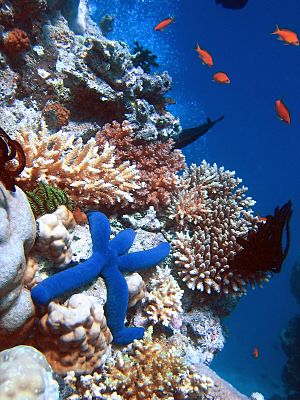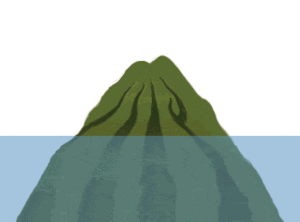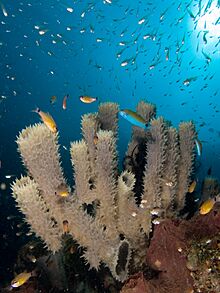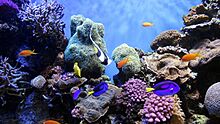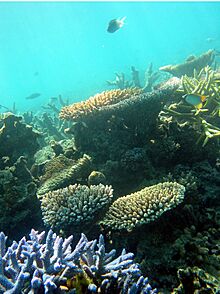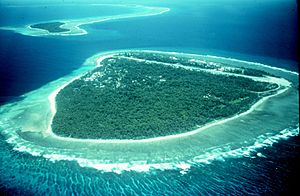Coral reef facts for kids
A coral reef is like an underwater city built by tiny animals called corals in warm, sunny parts of the ocean. Even though corals are super important for building the reef, tiny sea plants called algae (especially red algae) are actually the main builders that help the reef grow strong against ocean waves.
Coral reefs grow best in water that's between 20 and 28 degrees Celsius (68–82 degrees Fahrenheit). You can find coral reefs in all oceans except the Arctic Ocean. They usually live between the Tropic of Cancer and the Tropic of Capricorn, which are the warmer parts of the world.
Coral reefs come in different shapes and sizes:
- Apron reef — A short reef that slopes down from a point of land.
- Fringing reef — A reef that grows right next to the shoreline, following its shape.
- Barrier reef — A reef that is separated from the land by a body of water called a lagoon. The Great Barrier Reef is a famous example.
- Patch reef — A single, often round reef, usually found inside a lagoon or bay.
- Ribbon reef — A long, narrow, winding reef, often found in the lagoon of an atoll.
- Table reef — A single reef that looks like an atoll but doesn't have a lagoon inside.
- Atoll reef — A round or continuous barrier reef that surrounds a lagoon, but without any land in the middle.
Contents
How Coral Reefs Form
Most coral reefs we see today formed after the last ice age. When the ice melted, sea levels rose and covered the edges of the continents. This means many reefs are less than 10,000 years old. As new coral communities started growing, they built upwards, keeping pace with the rising water. If a reef couldn't grow fast enough, it became a drowned reef, too deep for sunlight to reach the corals.
You can also find coral reefs in the deep ocean, far from continents. These often grow around oceanic islands or as atolls. Most of these ocean islands started as volcanoes. Sometimes, movements of the Earth's plates can lift parts of the deep ocean floor to the surface, creating places for reefs to grow.
What Are Reefs Made Of?
Coral reefs are built from the hard skeletons of many generations of corals. These skeletons are made of something called calcium carbonate. When a tiny coral animal, called a polyp, dies, it leaves its skeleton behind. New polyps then grow on top of these old skeletons, making the reef bigger and bigger.
Fish like parrotfish, sea urchins, and sponges help break down old coral skeletons into tiny pieces. These pieces then fill in the gaps in the reef structure, making it even stronger.
Amazing Sea Life
Coral reefs are some of the busiest and most diverse places on Earth. They create many different marine habitats that support a huge variety of living things.
Reefs that are close to shore often work together with mangrove forests and sea grass meadows. The reefs protect the mangroves and seagrass from strong waves. In return, the mangroves and seagrass help keep the water clean for the corals by trapping dirt and pollution. This teamwork helps many animals, as they might feed in the seagrass and then use the reefs for safety or to have their babies.
Reefs are home to all sorts of animals, including:
- Fish
- Seabirds
- Sponges
- Jellyfish
- Worms
- Crustaceans (like shrimp and crabs)
- Mollusks (like octopus and squid)
- Starfish and sea urchins
- Sea turtles and sea snakes
Most mammals don't live on coral reefs, but dolphins sometimes visit. Some animals eat the corals directly, while others munch on the algae growing on the reef. The more different kinds of animals there are, the healthier the reef usually is.
Different animals use the same hiding spots on a reef at different times. Fish that hunt at night, like cardinalfish, hide during the day. Fish that are active during the day, like parrotfish, hide from predators like eels and sharks at night. The many hiding places on a reef are a big reason why so many different kinds of creatures can live there. Coral reefs also have a huge variety of tiny living things, like bacteria and fungi.
Threats to Coral Reefs
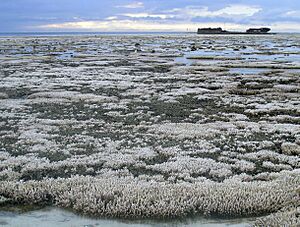
Sadly, coral reefs around the world have shrunk by 14% between 2009 and 2018. Many human activities can harm them:
- Coral mining: Taking corals for building materials.
- Bottom trawling: A type of fishing that drags nets along the seafloor, destroying reefs.
- Digging canals: Building channels for boats can damage marine homes.
- Blast fishing: Using explosives to catch fish, which destroys the reef.
- Overfishing: Catching too many fish, which throws off the balance of the reef ecosystem.
- Pollution: Chemicals from land, like those in some sunscreens, can hurt corals and their tiny algae helpers.
Bigger threats come from Greenhouse gas emissions, which cause:
- Warmer oceans: This leads to widespread coral bleaching, where corals lose their colorful algae and can die.
- Rising sea levels: This can make it harder for corals to get enough sunlight.
- Stronger storms: More powerful storms can break apart reefs.
- Ocean acidification: The ocean absorbs more carbon dioxide, making the water more acidic. This makes it harder for corals to build their skeletons.
Protecting Coral Reefs
Coral reefs are very delicate. Because corals need warm, sunny water, they often grow close to the surface. This makes them easy to damage from things like:
- Poisons and dirt: Pollution from boats and nearby land can make the water cloudy, blocking sunlight, or directly poison the corals, causing them to bleach and die.
- Boat accidents: Reefs are hard for ships to see, and boats can easily crash into them, damaging both the boat and the coral.
Because of these dangers, many countries are trying to limit building near beaches with coral reefs. They are also being more careful about boats traveling near reefs.
Protecting a reef by making it a biosphere reserve, marine park, national monument, or world heritage site can help keep it safe. For example, in Australia, the Great Barrier Reef is protected by special laws and a park authority.
Significant Coral Reefs
- The Great Barrier Reef — The largest reef system in the world, stretching over 2,600 kilometers (1,600 miles) off Queensland, Australia.
- The Mesoamerican Barrier Reef System — The second largest, stretching 1,000 kilometers (620 miles) from Mexico to Honduras.
- The New Caledonia Barrier Reef — The second longest double barrier reef, covering 1,500 kilometers (930 miles).
- The Andros, Bahamas Barrier Reef — The third largest, found along the east coast of Andros Island in the Bahamas.
- The Red Sea — Home to 6,000-year-old reefs along its 2,000 kilometer (1,240 mile) coastline.
- The Florida Reef Tract — The largest continental US reef and the third-largest barrier reef, stretching from Miami to the Dry Tortugas.
- Blake Plateau — Discovered in 2024, it has the world's largest known deep-water coral reef, stretching from Miami to Charleston, S. C.
- Pulley Ridge — The deepest photosynthetic coral reef, located in Florida.
- Many reefs around the Maldives.
- The Philippines coral reef area — The second-largest in Southeast Asia, with over 400 types of corals.
- The Raja Ampat Islands in Indonesia — Known for having the most diverse marine life in the world.
- Bermuda — Known for its northernmost coral reef system, kept warm by the Gulf Stream.
- The world's northernmost individual coral reef is in the Finlayson Channel, British Columbia, Canada.
- The world's southernmost coral reef is at Lord Howe Island, off the east coast of Australia.
Images for kids
-
Zooxanthellae are tiny algae that live inside coral, giving it color and food.
-
Eastern oysters (Crassostrea virginica)
-
How an atoll forms: It starts with a volcanic island.
-
Finally, the island sinks completely, leaving an atoll around a lagoon.
-
The shell of Latiaxis wormaldi, a coral snail.
See also
 In Spanish: Arrecife de coral para niños
In Spanish: Arrecife de coral para niños


